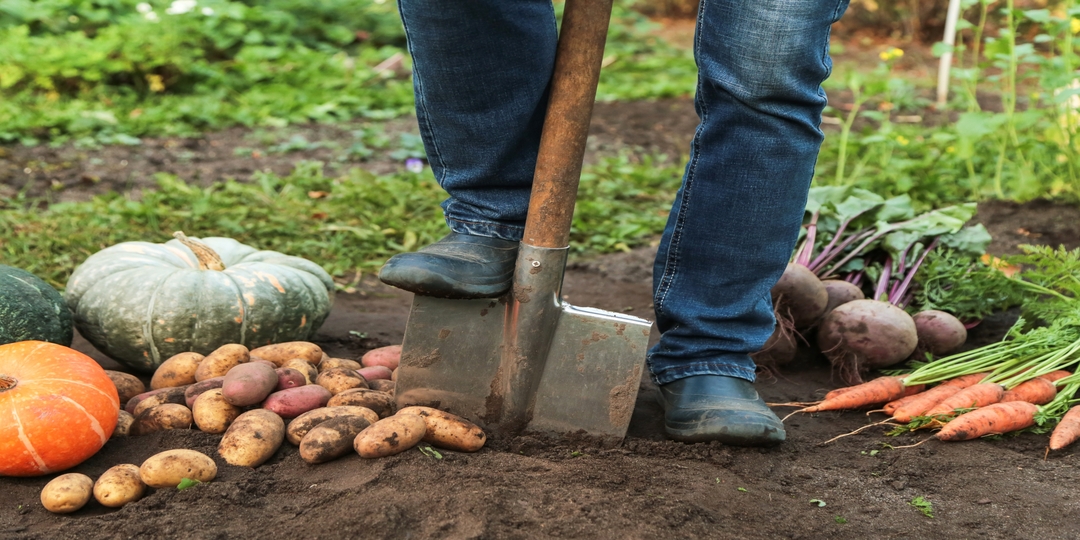
Final harvest checklist: October off-grid gardening jobs you can’t forget
Date Published: 15/10/2025
For off-grid gardeners, October is the month where every job counts: storing food, protecting soil, planting ahead. So, here’s your complete harvest checklist for October, ready to make sure all your bases are covered and your garden is in the best position for spring.
Jump to:
- Harvesting, storing & preserving: Getting the last from summer
- Off-grid vegetable patch: Planting overwintering & late season crops
- Spring bulbs & perennials
- Winterising and protecting your veg patch
- Garden tidying & prep for next season
Harvesting, storing & preserving: Getting the last from summer
Let’s begin with storing and preserving. Now is your last chance to gather crops before the frost creeps in.
- Pumpkins and winter squash: Harvest these once the skins are firm and the stems begin to dry and crack. Use pruners to cut the stem (leaving about 2-4 inches attached). After harvesting, cure them in a warm (21-27°C), dry, well-ventilated space for up to two weeks. This toughens the skin and improves storage life. Once cured, store your squash in a cool, dry area no warmer than 15°C with good air circulation. Properly stored, many winter squashes will keep well into the new year.
- Root crops (carrots, parsnips, beets, turnips): These cool-season crops are tolerant of the cold and can be left in the ground in milder climates, then harvested as needed. Simply add a thick layer of mulch to insulate them from the frost. If you live somewhere a little colder, lift the roots before the deep frost arrives.
- Apples, pears, and nuts: Harvest any fruits gently to avoid bruising, and store them in a dark, cool space (ideally around 1–4°C). Some apples can last up to half a year in proper conditions. For nuts like hazelnuts or walnuts, remove their outer husks and dry them in a warm, airy place for up to two weeks. Just don’t crack the shells too soon, and this shortens their storage life.
- Beans and peas: Let your podded beans and peas (e.g., runner beans, soybeans, or drying peas) mature and dry fully on the plant. The pods will become dry and brittle, which is when you can harvest and shell them. Once they’re dry, they can last over a year.
Top tip: You can also freeze them in small batches if you prefer a fresher texture.
Off-grid vegetable patch: Planting overwintering & late season crops
Keeping your crops alive through winter, or sowing more hardy varieties now, will guarantee food when spring begins to stir.
- Garlic and onions: Plant any garlic cloves and onions in well-drained beds – 2 inches deep, 6 inches apart. This gives them a head start for spring. Hardneck garlic needs a period of cold exposure to form proper bulbs, so these are great for overwintering.
- Winter salads: Make the most of your growing season by sowing cold-hardy greens into the ground – or into cold frames, cloches, or polytunnels for a bit of extra protection. Certain salad greens grow slowly in cooler temps and will provide fresh leaves through winter with relatively little effort. These include:
- Lamb’s lettuce
- Pak choi
- Mizuna
- Claytonia
- Winter purslane
- Spring cabbages and cauliflowers: Plant these in autumn so they can establish strong roots before winter. Choose varieties that work well for overwintering, like Spring Hero cabbage and Aalsmeer cauliflower. Plant in firm, fertile soil, spacing 12-18 inches apart – and keep an eye out for slug damage early on!
Keep your home warm and your supplies safe this winter! Get your affordable heating oil quote today with Your NRG for reliable fuel when you need it most.
Spring bulbs and perennials
October is the perfect time to think beyond winter and start planning for that beautiful spring bloom.
- Plant spring bulbs: Layer your spring bulbs at different depths in containers or beds to create a bulb lasagne and extend flowering time through spring. Choose bulbs with different bloom times to get the most colour possible.
- Perennial herbs: Hardy herbs like rosemary and thyme need a little support to survive harsh winters. In milder climates, just mulch around the base to protect the roots. If it’s colder, wrap them in fleeces or move pots under shelter.
Winterising & protecting your veg patch
Make sure your garden is insulated, well-fed, and protected from other hungry critters!
- Mulch winter beds: Straw, leaves, or seaweed protect roots, and feed the ground as they break down.
- DIY cloches and tunnels: Build with bamboo hoops and polythene or reclaimed materials to shield your salads and greens.
- Hotbeds: Layer fresh manure under a frame to create natural insulation for your winter crops.
- Greenhouse care: Clean greenhouse glass to get the most out of the winter daylight. Try insulating with bubble wrap, and double-check your vents for good airflow.
- Rodent-proof stores: Seal gaps, raise food off the ground, and keep grain and compost heaps in sealed tins or barrels to make it harder for any mice or rats to find their way into them.
Garden tidying & prep for next season
October is a great time to prepare systems and storage so winter is a little easier, and spring is even more productive.
- Prepare rainwater catchment: Set up or service your rainwater harvesting system. Fit barrels or IBC tanks to your roof gutters using diverters or a downspout connector. Not only will this give you some water on hand if pipes freeze up, but it also keeps you from having to carry water from further away, which can be dangerous in icy conditions.
- Root storage pits: Dig earth or straw clamps for carrots, beets, and potatoes. Low-tech refrigeration that works all winter.
- Wood and fuel: Cut, split, and stack logs now so they’re seasoned and ready to burn. If you rely on home heating oil, now’s the time to check levels and top up your tank before frost makes deliveries harder.
- Support wildlife: Leave any log piles, seed heads, and leaf mould bins to create shelter for hedgehogs, ladybugs, and beetles, who will make quick work of any pests like slugs or aphids.
- Tool care: Clean, oil, and store tools in a dry place so they’re sharp and ready when spring arrives.
Fuel up this winter with Your NRG
Winter’s on the way, so make sure your off-grid home is ready. At Your NRG, we deliver domestic heating oil across the UK with reliable service, fair prices, and even next-day delivery. Whether you're heating your home or protecting your crops, we’ve got you covered with the fuel to carry you through winter. Get your free heating oil quote today!
Final harvest checklist FAQs
When should I plant spring bulbs in the UK?
Spring bulbs in the UK should be planted between September and November, before the ground freezes. Tulips are best planted in late October or November to reduce disease risk, while daffodils, crocuses, and hyacinths can go in earlier, from mid-September onwards. Choose a sunny, well-drained spot and plant bulbs at a depth of 2–3 times their height.
What vegetables can be sown in October?
October is a great month for sowing hardy vegetables that can withstand cooler weather. Some good options include:
- Garlic – Plant cloves for harvest the following summer.
- Onions and shallots – Overwintering varieties do well when planted now.
- Spinach – Hardy types provide fresh leaves through winter.
How do I store potatoes and onions properly?
To store potatoes and onions properly, keep them in a cool, dark, and well-ventilated space. Cure potatoes for 10–14 days in a dry, dark area before storing in hessian sacks or paper bags. Onions should be dried until the necks are fully sealed, then stored in mesh bags or braided and hung. Avoid plastic bags, as they trap moisture and cause rot.
Should I prune shrubs in October?
It depends on the type of shrub. Spring-flowering shrubs (like forsythia or lilac) should not be pruned in October, as you risk cutting off next year’s flower buds. Instead, prune them just after flowering in spring or early summer.
Shrubs that flower later in the year (like buddleia, fuchsia, or roses) can be cut back lightly in October to tidy them and reduce wind damage over winter. Save harder pruning for late winter or early spring. Always remove any dead, diseased, or damaged branches at this time of year.
How do I protect plants from early frost?
Protect plants from early frost by using garden fleece, cloches, or cold frames to trap warmth overnight. Mulch around the base of tender plants with straw or leaves to insulate roots. Move pots indoors or close to walls for added shelter. For crops like tomatoes and peppers, harvest mature fruit and ripen indoors before frost hits.
Explore our other articles

Your NRG donates unused office furniture...
Your NRG donates preloved office furniture to local charity Age UK
Date published: 18/11/2024
How Do Weather & Seasonal Changes Affect...
If you rely on heating oil to keep your home warm, you’ve likely noticed ho...
Date published: 06/03/2025
WebOil Acquisition & Major Expansion – F...
Your NRG has acquired WebOil, expanding fuel delivery from the Lake Distric...
Date published: 12/09/2025





























